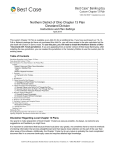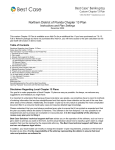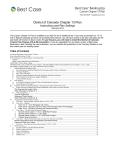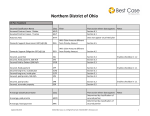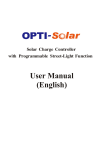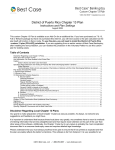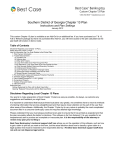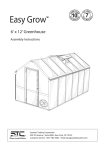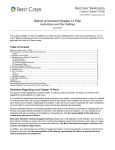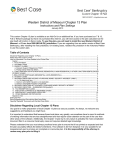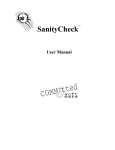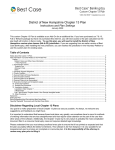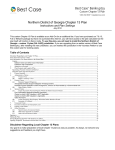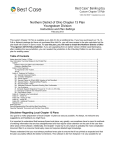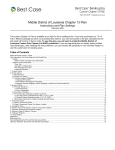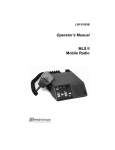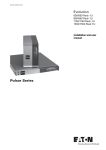Download Eastern District of Missouri Chapter 13 Plan
Transcript
Eastern District of Missouri Chapter 13 Plan Instructions and Plan Settings January 2014 This custom Chapter 13 Plan is available as an Add-On for an additional fee. If you have purchased our 7 & 13, Full or Network package but have not purchased this Add-On, you will have access to the plan calculator but the plan itself will function in Demo mode. To use this plan, you will need to install the Eastern District of Missouri ~13 plan rev 01/07 (MO- E-ZY) jurisdiction. If you are upgrading from an earlier version of Best Case Bankruptcy, after installing the new jurisdiction, you can reselect the jurisdiction in the Voluntary Petition to use this custom plan for existing cases. Table of Contents Notes about this Custom 13 Plan ............................................................................................................................................................... 2 How Information You Enter Relates to the Printed Plan ............................................................................................................................ 4 Caption ................................................................................................................................................................................................... 4 Payments ..................................................................................................................................................................................................... 4 Plan Payment Details............................................................................................................................................................................. 4 Tax Refunds and Lump Sum Payments ............................................................................................................................................... 5 Minimum Payment to Non-Priority Unsecured Creditors ...................................................................................................................... 5 Disbursements ............................................................................................................................................................................................. 5 1. Trustee and Court Fees ..................................................................................................................................................................... 5 2. Executory Contract/Lease Arrears .................................................................................................................................................... 5 3(A). Post-petition real property lease payments.................................................................................................................................. 5 3(B). Post-petition personal property lease payments.......................................................................................................................... 6 3(C). Continuing Debt Payments on Real Estate Other Than the Debtor’s Residence ...................................................................... 6 3(D). Post-petition mortgage payments on Debtor’s residence ........................................................................................................... 6 3(E). DSO claims in equal installments ................................................................................................................................................. 7 4. Attorney Fees ..................................................................................................................................................................................... 7 5(A). Pre-petition arrears on secured claims paid in paragraph 3 ....................................................................................................... 7 5(B). Secured Claims to be paid in full .................................................................................................................................................. 7 5(C). Secured Claims subject to modification ....................................................................................................................................... 8 5(D). Co-debtor guaranteed debt paid in equal installments ................................................................................................................ 8 6. Additional Attorney Fees.................................................................................................................................................................... 9 7(A). Unsecured Co-debtor guaranteed claim ...................................................................................................................................... 9 7(B). Assigned DSO Claims .................................................................................................................................................................. 9 8. Priority Claims .................................................................................................................................................................................... 9 9(A). General Unsecured Claims ........................................................................................................................................................ 10 9(B). Surrender of Collateral ................................................................................................................................................................ 11 9(C). Rejected Executory Contracts/Leases ....................................................................................................................................... 11 10. Other............................................................................................................................................................................................... 11 11-14. General Plan Provisions ........................................................................................................................................................... 11 Signatures .................................................................................................................................................................................................. 11 Editing the Plan .......................................................................................................................................................................................... 11 Saving (Replacing) the Plan with the Best Case Editor ..................................................................................................................... 12 Opening “Replaced” Documents with the Best Case Editor .............................................................................................................. 12 Disclaimer Regarding Local Chapter 13 Plans Our goal is to make preparation of local Chapter 13 plans as easy as possible. As always, we welcome any suggestions and feedback you might have. It is important to understand that because these local plans vary greatly, we sometimes have to resort to methods of entering information that are less straightforward and that require closer attention on the part of the user than other areas of the software. Additionally, the Chapter 13 plan by its very nature is probably the most complicated document filed in a consumer bankruptcy case and requires detailed legal knowledge. 2 Please understand that you must always proofread every plan to ensure that it has printed as expected and that the plan accurately reflects the debtor’s intentions. This software is far from foolproof. It is very possible for an inexperienced user to produce an incomplete or inaccurate plan. It is the responsibility of the attorney to review every plan prior to filing it. Best Case Solutions’ technical support staff can advise you on the operation of the software, such as how to get a claim to print as you want on the form, but the actual decision about how to classify a given claim is a legal question that must be resolved by the responsible attorney. The Best Case technical support staff does not and can not dispense legal advice. In addition, your local trustee can modify or change the Chapter 13 plan requirements, practices or the format of the plan at any time. It is the responsibility of the attorney representing the debtor to ensure that local rules and practices are adhered to. Notes about this Custom 13 Plan Attorney’s Fees and Filing Fees: You can input attorney’s fees and filing fees to be paid through the plan in the Claims tab of the Chapter 13 Plan Calculator. The attorney’s fees will print in Section 4, and the filing fees will appear in Section 1, Trustee and Court Fees. Classifying Claims: When you are preparing a Chapter 13 filing in Best Case, the creditor entry window for each creditor you enter into Schedules D, E and F includes a "13 Plan Treatment" tab. In the 13 Plan Treatment tab, you can assign a treatment class to the creditor which specifies how you want it to be treated under the 13 Plan. The treatment class determines when the creditor will be paid in relation to other creditors, whether the claim will be paid through the plan or outside the plan, whether it will be paid in pro rata or fixed installments. The treatment class also determines under which section of the plan the claim information will print and whether or not the claim will extend beyond the life of the plan. In addition to the standard Best Case plan classes, as described in the Chapter 13 Plan Treatment: Treatment Classes topic in your on line help system or the Reference Table of Treatment Classes in The Chapter 13 Plan Section of your User's Guide, when you set the jurisdiction file for your client to the Eastern District of Missouri ~13 plan rev 01/07 jurisdiction, you will also find several custom plan classes to aid in the handling of claims: CDP-Continuing Debt Payments is the plan classification you will use for any claim you want to include in Section 3(C) of the plan. Claims of this class will continue beyond the life of the plan, but they will be paid a fixed amount through the plan based on the payment information you enter in the creditor’s 13 Plan Treatment tab. ELP-Personal property lease payments: If the debtor is assuming an executory contract or lease for any personal property, and he will be making the lease payments through the plan, you can use the ELP-Personal property lease payments plan class to list the lease in Section 3.B. of the Plan. These claims will be paid a fixed amount through the plan based on the payment information you enter in the creditor’s 13 Plan Treatment tab. (Note that if you specify an arrearage amount for any claims classified as ELP the arrearage information for these claims will automatically be included in Section 2, Executory Contract\Lease Arrearages.) ELRD-Exec Contract/Lease paid by debtor and ELRT-Exec Contract/Lease paid by trustee are the plan classifications you should use if you want to include an assumed contract or lease for real property in Section 3(A). of the plan. If the debtor is going to continue making the regular lease payments outside of the plan, classify the claim as Exec Contract/Lease paid by debtor. For leases that will be paid through the plan, use the Exec Contract/Lease paid by trustee plan class. ELRT claims will be paid a fixed amount through the plan based on the payment ©2013 Best Case, LLC 1.800.492.8037 www.bestcase.com 3 information you enter in the creditor’s 13 Plan Treatment tab. (Note that if you specify an arrearage amount for any claims classified as ELRD or ELRT the arrearage information for these claims will automatically be included in Section 2, Executory Contract\Lease Arrearages.) 5DCC-#5D Codebtor claim, codebtor pays and 5DCT-#5D Codebtor claim, trustee pays claims will be included under Section 5(D). of your custom plan. Use the 5DCC-#5D Codebtor claim, codebtor pays class if the co-debtor is going to be repaying the claim outside of the plan. If the claim is to be paid through the plan, you can use the 5DCT-#5D Codebtor claim, trustee pays plan class. 5DCT claims are paid in the fixed monthly installment you specify in the creditor’s 13 Plan Treatment tab, and they will be paid in full by the end of the plan. U1AC-#7A Unsecured claim, codebtor pays and U1AT-#7A Unsecured claim, trustee pays are used for unsecured co-debtor guaranteed claims to be included under Section 7(A). of the plan. The U1AC-#7A Unsecured claim, codebtor pays class should be used for any unsecured co-debtor guarantee claim that will be paid directly to the creditor. If the claim is going to be paid through the plan, you may want to use the U1AT-#7A Unsecured claim, trustee pays plan class. U1AT claims are paid in full on a pro rata basis. They are of payout rank three which means they will be paid after other secured and priority creditors but ahead of other Schedule F claims. Note: For a complete description of how each available Best Case standard plan class works, consult the Chapter 13 Plan Treatment: Treatment Classes topic in your on line help system or the Reference Table of Treatment Classes in The Chapter 13 Plan Section of your User's Guide. Curing Domestic Support Arrearages Through the Plan: Generally, the debtor will pay post petition domestic support obligations directly to the creditor, so the claim amount is not included in plan payment calculations. However, if the debtor is behind in his payments to one of these creditors, you may want to pay the arrearage through the plan. If you have a domestic support obligation with an arrearage that you want to pay through the plan: 1. Include the arrearage in the Claim amount in the creditor information tab. 2. Open the 13 Plan Treatment tab and classify the priority portion of the claim as DSO-Domestic Support Obligation or DSG-Domestic Support Government. 3. Enter the arrearage amount in the Arrearage section of the 13 Plan Treatment tab. 4. Classify the arrearage portion of the claim as either Arrearage, paid prorata or Arrearage, fixed payment. 5. Fill in the Arrearage Interest Rate, and the fixed payment information if applicable. 6. Click OK to save your changes. Custom Entry Screen: Your plan includes an Eastern District of Missouri - Chapter 13 Plan custom entry screen which allows you to enter additional information for the Payments section of you plan, as well as specifying an interest rate for Secured Claims listed in Sections 5.B. and 5.C. of the plan. To access this screen, pictured below, open the Chapter 13 Plan Calculator and then click the MOE 13 Plan Info button in the upper right corner. (Note that this custom entry screen is only visible when you set ©2013 Best Case, LLC 1.800.492.8037 www.bestcase.com 4 the jurisdiction for the client file to the Eastern District of Missouri ~13 plan rev 01/07.) Including Assumed Contract/Lease Information on Your Plan: Sections 2, 3(A), and 3(B) of your plan list payment information for assumed executory contracts and unexpired leases. In order to include this information on your plan, you will need to create a dummy creditor for the claim on either Schedule D or F. In the Creditor information tab, enter the name of the contract/lease party. In the property description field/consideration field, type in a description of the collateral the lease secures. For the claim amount and market value, enter in the total of all payments the debtor will make during the life of the plan plus any arrearage owed. In the 13 Plan Treatment tab, classify the main portion on the left as ELP-Personal property lease payments, ELRD-Exec Contract/Lease paid by debtor or ELRT-Exec Contract/Lease paid by trustee, and enter in the necessary payment information. If there is an arrearage that you want to list it in Section 2, enter the information in the Arrearage section on the right side of the 13 Plan Treatment tab. If you don’t want this claim to appear on the Schedule, put a check in the box labeled “Do Not Print/Total on Sch.” in the upper right corner of the Creditor Information tab. The Exclude from Mailing Matrix checkbox will stop this creditor from appearing in the Matrix. Form Preferences: Your custom plan includes three special form preferences which allow you to: 1. Print the amount available for unsecured creditors from the Liquidation Analysis for the minimum payment to unsecured creditors in the Payments section of the plan instead of the percentage for unsecured creditors from the Summary tab of the 13 calculator with. 2. Print the §1325(b) income calculation in Section 9.a, even if the debtor is below the Median Income. 3. Add permanent text to the Other Provisions section of the plan which prints for every Chapter 13 Client. To access the Form Preference window: (1) Highlight the Chapter 13 Plan on the Forms and Schedules Menu for the client. (2) Click Setup/Edit Form Preferences. (3) Highlight the form preference and click Change. (4) Set the form preference to “Yes” or “No,” or enter your text. (5) Click OK to save, and then click Close on the next screen to return to the Forms and Schedules Menu. How Information You Enter Relates to the Printed Plan Caption The division name for the caption on the first page of the Chapter 13 Plan is taken from the jurisdiction name in the jurisdiction section of your Setup Menu. Note that if there is a tilde character ~ in your jurisdiction name, it will not print on the plan nor will any text following the tilde. The debtor names are drawn from the data entered in the Voluntary Petition. The case number and the confirmation hearing date, time, and location are entered in the Case button in the toolbar. Payments Plan Payment Details Your custom plan asks you to complete one of three payment options. Best Case will fill in one of these options based on the payment information you enter in either the Summary tab of the Chapter 13 Plan Calculator or the Eastern District of Missouri - Chapter 13 Plan custom entry screen. The first payment option will be filled in if there are no step payments entered in the Chapter 13 Plan Calculator and you have not completed the Plan Payment Section of the Eastern District of Missouri - Chapter 13 Plan custom entry screen. The payment amount and the plan length will print based on the payment amount and duration you specify in the Chapter 13 Plan Calculator. ©2013 Best Case, LLC 1.800.492.8037 www.bestcase.com 5 The second payment option will be filled in if you have specified a step plan in the Chapter 13 Plan Calculator and you have not completed the Plan Payment Section of the Eastern District of Missouri - Chapter 13 Plan custom entry screen. For each step in the plan, the payment amount and the number of months will print based on the payment amounts and durations you specify in the Chapter 13 Plan Calculator. To fill out the third payment option, click on the MOE 13 Plan Info button in the top right corner of the Chapter 13 Plan Calculator. In the Eastern District of Missouri - Chapter 13 Plan screen that opens, by selecting the radio button “Enter Payment Plan”, you can modify the plan payment and duration for both steps, as well as the start date for the second step. Note: If you fill in the data for the third payment option in the custom entry screen, it overrides the first two options, and Best Case will automatically fill out the third payment option on the plan, even if a different plan payment, duration or step method is specified in the Chapter 13 Plan Calculator. Tax Refunds and Lump Sum Payments If your plan payment schedule includes any lump sum payments, then the amounts and the month numbers of the payments will print here based on the information you specify in the Chapter 13 Plan Calculator. Minimum Payment to Non-Priority Unsecured Creditors Best Case automatically fills in the minimum payment information based on the percentage you specify for unsecured, non-priority claims in the Summary Tab of the Chapter 13 Plan Calculator. If these creditors are to be paid in full, then Best Case will print “100%” here. If these claims will not be paid in full, then Best Case will calculate the total payments these creditors will receive and print the dollar amount here. For more information about changing the payments to unsecured creditors, consult the Chapter 13: Plan Summary Tab section of your user’s manual or the help file. Disbursements 1. Trustee and Court Fees The filing fee that prints in this section of the plan is taken from the amount you entered for the unpaid filing fees to be paid through the plan in the Claims tab of the Chapter 13 Plan Calculator. 2. Executory Contract/Lease Arrears If the debtor is curing an arrearage on an assumed executory contract or lease through the plan, the arrearage information for the claim will print here. In order to list a contract or lease arrearage in this section of the plan, you will need to create a dummy creditor for the claim, as described in “Notes about this Custom 13 Plan” on page 2 of these instructions, classify the main portion of the claim as ELP-Personal property lease payments, ELRDExec Contract/Lease paid by debtor or ELRT-Exec Contract/Lease paid by trustee and specify an arrearage amount for the claim greater than $0.00. Plan Headings: Creditor Name is the Creditor Name as entered in the Creditor Information tab. Total Amount Due equals the total amount that will be paid to cure the arrearage, including interest paid at the rate you specify in the 13 Plan Treatment tab. Cure Period: If the arrearage portion of the claim is classified as ARR-Arrearage, fixed payment, the cure period equals the term you entered for the arrearage in the 13 Plan Treatment tab. If the arrearage is classified as ARPR-Arrearage, paid prorata the cure period is the total number of months needed to repay the arrearage claim as computed by the Chapter 13 Plan Calculator. 3(A). Post-petition real property lease payments Regular payment information for executory contracts for real property is listed in this section of the plan. If the debtor is going to assume a lease or contract on real property, you will need to create a dummy creditor for the claim, as described in “Notes about this Custom 13 Plan” on page 2 of these instructions and classify the main portion of the claim as ELRD-Exec Contract/Lease paid by debtor or ELRT-Exec Contract/Lease paid by trustee in the creditor’s 13 Plan Treatment tab. ELRT claims will be paid a fixed amount through the plan, while ©2013 Best Case, LLC 1.800.492.8037 www.bestcase.com 6 ELRD claims will be paid directly to the contract or lease holder and will not be included in the plan payment calculations. Plan Headings: Creditor Name is the Creditor Name as entered in the Creditor Information tab. Monthly Payment equals the fixed payment amount you specify for the claim in the 13 Plan Treatment tab. By Debtor/Trustee: If the claim is classified as ELRD-Exec Contract/Lease paid by debtor, the word “Debtor” will print in this column. If the claim is classified as ELRT-Exec Contract/Lease paid by trustee, “Trustee” will print here. 3(B). Post-petition personal property lease payments Regular payment information for executory contracts for personal property is listed in this section of the plan. If the debtor is going to assume a lease or contract on personal property and will be paying it through the plan, you will need to create a dummy creditor for the claim, as described in “Notes about this Custom 13 Plan” on page 2 of these instructions and classify the main portion of the claim as ELP-Personal property lease payments in the creditor’s 13 Plan Treatment tab. ELP claims are paid a fixed amount through the plan based on the payment information you enter in the creditor’s 13 Plan Treatment tab. Plan Headings: Creditor Name is the Creditor Name as entered in the Creditor Information tab. Monthly Payment equals the fixed payment amount you specify for the claim in the 13 Plan Treatment tab. Est. Months Remaining represents the term you entered for the secured portion of the claim in the 13 Plan Treatment tab. 3(C). Continuing Debt Payments on Real Estate Other Than the Debtor’s Residence In order to designate a secured claim as a mortgage claim for real property other than the debtor’s residence, you must classify it as CDP-Continuing Debt Payments. Claims of this class will continue beyond the life of the plan, but they will be paid a fixed amount through the plan based on the payment information you enter in the creditor’s 13 Plan Treatment tab. If there is an arrearage on the claim that you want to pay through the plan, you can do so by entering the arrearage amount in the Arrearage Portion section of the 13 Plan Treatment tab and classifying it as ARR-Arrearage, fixed payment or ARPR-Arrearage, paid prorata. The arrearage will be listed in Section 5(A). with detailed information regarding the total amount due, cure period and interest rate. Plan Headings: Creditor Name is the Creditor Name as entered in the Creditor Information tab. Monthly Payment: If the secured portion of the claim is classified as CDP-Continuing Debt Payments, the monthly payment amount that you enter on the 13 Plan Treatment tab prints here. 3(D). Post-petition mortgage payments on Debtor’s residence This section of the plan prints the information for mortgage claims secured by the debtor’s residence. Any claim classified as SLTO-Secured, long term, outside plan or SLTP-Secured, long term, in plan will print in this section of the plan if you include the word “Mortgage” in the Nature of Lien field for the creditor. SLTO claims will be paid outside the 13 plan, and the payments will extend beyond the length of the plan. This claim will be printed on the plan with the monthly payment amount that the debtor will be making, but will not be included in the Chapter 13 Plan Calculator's computations. SLTP claims also extend beyond the life of the plan, but they will be paid a fixed amount each month through the plan, which you will specify in the 13 Plan Treatment tab for each claim. If there is an arrearage on the claim that you want to pay through the plan, you can do so by entering the arrearage amount in the Arrearage Portion section of the 13 Plan Treatment tab and classifying it as ARRArrearage, fixed payment or ARPR-Arrearage, paid prorata. ©2013 Best Case, LLC 1.800.492.8037 www.bestcase.com 7 Plan Headings: Creditor Name is the Creditor Name as entered in the Creditor Information tab. Monthly Payment equals the fixed payment amount you specify for the claim in the 13 Plan Treatment tab. By Debtor/ Trustee: If the claim is classified as SLTO, the word “Debtor” will print in this column. If the claim is classified as SLTP, “Trustee” will print here. 3(E). DSO claims in equal installments This section of the plan lists the arrearage information for priority domestic support obligations included in the debtor’s petition. Any claim for which the priority portion has been classified as DSO - Domestic Support Obligation will be included here. Note that DSO claims are not included in the plan payment calculations, so if you want to include an arrearage owed to the creditor in the plan payments, you will need to specify a separate treatment for the arrearage portion, in the creditor’s 13 Plan Treatment tab. (See page 2 for more information on how to include a domestic support arrearage in the plan payments.) Plan Headings: Creditor Name is the Creditor Name as entered in the Creditor Information tab. Total Amount Due equals the total amount that will be paid to cure the arrearage, including interest paid at the rate you specify in the 13 Plan Treatment tab. Interest Rate represents the interest rate you specify for the arrearage portion of the claim in the 13 Plan Treatment tab. 4. Attorney Fees The attorney fees that print in this section of the plan are taken from the balance of unpaid attorney’s fees you entered in the claims tab of the Chapter 13 Plan Calculator. The number of months will be automatically calculated by the chapter 13 plan calculator. 5(A). Pre-petition arrears on secured claims paid in paragraph 3 Arrearage information for any secured claim listed on Schedule D will print in this section of the plan if the secured portion of the claim is classified as SLTO-Secured, long term, outside plan, SLTP-Secured, long term, in plan, SFP-Secured, fixed payment, SPR-Secured, paid prorate or CDP-Continuing Debt Payments and the claim includes an arrearage portion greater than $0.00. Plan Headings: Creditor Name is the Creditor Name as entered in the Creditor Information tab. Total Amount Due equals the total amount that will be paid to cure the arrearage, including interest paid at the rate you specify in the 13 Plan Treatment tab. Cure Period: If the arrearage portion of the claim is classified as ARR-Arrearage, fixed payment, the cure period equals the term you entered for the arrearage in the 13 Plan Treatment tab. If the arrearage is classified as ARPR-Arrearage, paid prorata the cure period is the total number of months needed to repay the arrearage claim as computed by the Chapter 13 Plan Calculator. Interest Rate represents the interest rate you specify for the arrearage portion of the claim in the 13 Plan Treatment tab. 5(B). Secured Claims to be paid in full Claims classified as SFP-Secured, fixed payment or SPR-Secured, paid prorata will be listed under this section of the plan, if there is no unsecured portion specified in the creditor’s 13 Plan Treatment tab. Claims classified as SFP and SPR will be paid in full up to the secured amount listed on the 13 Plan Treatment tab. If you have a claim that includes an unsecured portion, but you want to include it in this section of the plan, simply check the "Pay Full Claim as Secured" checkbox in the creditor’s 13 Plan Treatment tab. When you check this ©2013 Best Case, LLC 1.800.492.8037 www.bestcase.com 8 box, the unsecured portion of the claim is automatically added back to the secured claim amount and the Chapter 13 Plan Calculator pays the claim in full when it calculates the plan payments. Specifying an interest rate: In the instructions for this section, your plan asks you to specify the interest rate at which the creditors listed here will be paid. By default, Best Case will leave the interest rate blank. If you want to specify an interest rate to print here, you can do so in the Eastern District of Missouri - Chapter 13 Plan custom entry screen as described in “Notes about this Custom 13 Plan” on page 2 of these instructions. (Note that the interest rate specified in the custom entry screen will not be applied to claims listed under this section of the plan, nor will it affect Chapter 13 Plan calculations. The interest paid to claims listed in this section of the plan will be calculated based on the interest rate you set in the 13 Plan Treatment tab for each individual creditor.) Plan Headings: Creditor is the Creditor Name as entered in the Creditor Information tab. Estimated Balance Due equals the secured portion of the claim that you specified in the 13 Plan Treatment tab. Repay Period: If the secured portion of the claim is classified as SFP, the repay period equals the term you entered for the claim in the 13 Plan Treatment tab. If the secured portion is classified as SPR the repay period is the total number of months needed to payoff the claim as determined by the Chapter 13 Plan Calculator. Total w/ Interest equals the total amount that will be paid on the claim, including interest paid at the rate you specify in the 13 Plan Treatment tab for the creditor. 5(C). Secured Claims subject to modification Any claim classified as SFP-Secured, fixed payment or SPR-Secured, paid prorata will be listed under this section of the plan if the claim includes an unsecured portion. Specifying an interest rate: In the instructions for this section, your plan asks you to specify the interest rate at which the creditors listed here will be paid. By default, Best Case will leave the interest rate blank. If you want to specify an interest rate to print here, you can do so in the Eastern District of Missouri - Chapter 13 Plan custom entry screen as described in “Notes about this Custom 13 Plan” on page 2 of these instructions. (Note that the interest rate specified in the custom entry screen will not be applied to claims listed under this section of the plan, nor will it affect Chapter 13 Plan calculations. The interest paid to claims listed in this section of the plan will be calculated based on the interest rate you set in the 13 Plan Treatment tab for each individual creditor.) Plan Headings: Creditor is the Creditor Name as entered in the Creditor Information tab. Balance Due equals the claim that you specified in the Creditor Information tab. FMV: The fair market value of the property is taken from the Market value of the claim as listed in the Creditor Information tab. Repay Period: If the arrearage portion of the claim is classified as SFP, the repay period equals the term you entered for the claim in the 13 Plan Treatment tab. If the arrearage is classified as SPR the repay period is the total number of months needed to payoff the claim as determined by the Chapter 13 Plan Calculator. Total w/Interest equals the total amount that will be paid on the claim, including interest paid at the rate you specify in the 13 Plan Treatment tab for the creditor. 5(D). Co-debtor guaranteed debt paid in equal installments Claims classified as 5DCC-#5D Codebtor claim, codebtor pays and 5DCT-#5D Codebtor claim, trustee pays will be included under Section 5(D). of your custom plan. Use the 5DCC-#5D Codebtor claim, codebtor pays class if the co-debtor is going to be repaying the claim outside of the plan. If the claim is to be paid through the plan, you can use the 5DCT-#5D Codebtor claim, trustee pays plan class. 5DCT claims are paid in the fixed monthly installment you enter in the creditor’s 13 Plan Treatment tab, and they will be paid in full by the end of the plan. ©2013 Best Case, LLC 1.800.492.8037 www.bestcase.com 9 Plan Headings: Creditor Name is the Creditor Name as entered in the Creditor Information tab. Estimated Balance equals the claim that you specified in the Creditor Information tab. Trustee/ Co-Debtor: If the claim is classified as 5DCC, the word “Co-Debtor” will print in this column. If the claim is classified as 5DCT, “Trustee” will print here. Period represents the term length you specified for the secured portion of the claim in the 13 Plan Treatment tab. Interest Rate is the interest rate you specify for the secured portion of the claim in the 13 Plan Treatment tab. 6. Additional Attorney Fees The attorney fees that print in this section of the plan are specified in the Eastern District of Missouri - Chapter 13 Plan custom entry screen as described in “Notes about this Custom 13 Plan” on page 2 of these instructions. 7(A). Unsecured Co-debtor guaranteed claim Claims classified as U1AC-#7A Unsecured claim, codebtor pays and U1AT-#7A Unsecured claim, trustee pays will be included under this section of the plan. The U1AC-#7A Unsecured claim, codebtor pays class should be used for any unsecured co-debtor guarantee claim that will be paid directly to the creditor. If the claim is going to be paid through the plan, you can use the U1AT-#7A Unsecured claim, trustee pays plan class. U1AT claims are paid in full on a pro rata basis. They are of payout rank three which means they will be paid after other secured and priority creditors but ahead of other Schedule F claims. Plan Headings: Creditor Name is the Creditor Name as entered in the Creditor Information tab. Estimated Total Due equals the claim that you specified in the Creditor Information tab. Trustee/Co-Debtor: If the claim is classified as U1AC -#7A Codebtor claim, codebtor pays, the word “Co-Debtor” will print in this column. If the claim is classified as U1AT-#7A Unsecured claim, trustee pays, “Trustee” will print here. Interest Rate is the interest rate you specify for the secured portion of the claim in the 13 Plan Treatment tab. 7(B). Assigned DSO Claims This section of the plan lists the arrearage information for any priority domestic support obligations assigned to, or recoverable by, a governmental unit. Any claim for which the priority portion has been classified as DSG Domestic Support Government will be included here. Note that DSG claims are not included in the plan payment calculations, so if you want to include an arrearage owed to the creditor in the plan payments, you will need to specify a separate treatment for the arrearage portion, in the creditor’s 13 Plan Treatment tab. (See page 2 for more information on how to include a domestic support arrearage in the plan payments.) Plan Headings: Creditor is the Creditor Name as entered in the Creditor Information tab. Total Due equals the Claim Amount as entered in the Creditor Information tab. Total Amount Paid By Trustee equals the total amount that will be paid to the creditor, including interest paid at the rate you specify in the 13 Plan Treatment tab. 8. Priority Claims All claims classified as UPR – Unsecured, Priority will print in this section of the plan. These are generally Schedule E claims. Creditors of this class will be paid on a pro rata basis, and they will receive the full value of their claim plus any interest you specify in the 13 Plan treatment tab. Note that the Interest rates for these claims are not included in this section of the plan. If you are specifying an interest rate for an Unsecured, Priority ©2013 Best Case, LLC 1.800.492.8037 www.bestcase.com 10 creditor, you may want to note this in the Other tab in the Chapter 13 Plan Calculator so that it prints in the Other Provisions section of your plan. Plan Headings: Creditor Name is the Creditor Name as it was as entered on the Creditor Information tab. Total Amount Due equals the total amount that will be paid to the creditor, including interest paid at the rate you specify in the 13 Plan Treatment tab. 9(A). General Unsecured Claims Claims that have been classified as UGEN–Unsecured, general, nonpriority are handled in this section of the plan. Unsecured General Non-priority is the most common treatment class for Schedule F claims. These claims are paid prorata and are paid after all other claims have been paid. The amount that they are paid varies, depending on how much the debtor is able to pay into the plan. All creditors in this class will have the same percentage of their claims paid. (For more information about changing the payments to unsecured creditors, consult the Chapter 13: Plan Summary Tab section of your user’s manual or the help file) Estimated Total Owed: The estimated total owed to general unsecured creditors represents the total of all UGEN claims listed on Schedule F plus the non-priority portion of all claims listed on Schedule E plus the total of the unsecured portions of all claims listed on Schedule D. Estimated Amount Available represents the total payments to UGEN creditors through the plan. Best Case calculates this number based on the percentage you designate for general non-priority claims in the Summary tab of the Chapter 13 Plan Calculator. Estimated Repayment in Chapter 7: The estimated repayment is the amount “Available to General Unsecured” from the Liquidation tab of the 13 Plan Calculator. In short, this number represents the amount of the debtor’s unsecured property that is left after all secured and priority claims, the exempt property and any administrative costs are subtracted from the debtor’s total assets. (For a more complete description of how Best Case calculates the liquidation analysis, see the Liquidation Analysis section of you user’s manual or the help file.) The Amount required to be paid to non-priority unsecured creditors as determined by 1325(b) calculation represents the debtor’s monthly disposable income (DMI) from line 44 of Form 22C-2 multiplied by the Applicable Commitment Period from line 21 of 22C-1. Best Case automatically fills in this amount based on the information you enter in the Means Test Calculator for Form 22C. Print the DMI when the Debtor is Below Median Income: According to the directions for Form 22C-1, if the Debtor’s Annualized Current Monthly Income from either Line 15b or Line 20b is below the Median Income, the debtor is not required to determine his disposable income under § 1325(b)(3) and therefore should not complete the entire form. In these instances, Best Case will leave the1325(b) required payment section of the Chapter 13 Plan blank. If the debtor is below the median, and you want Best Case to print the 1325(b) income, you must do both of the following: 1. Set the "Always Print 1325(b) calculation for Section 9(A)?"form preference to “Yes.” (See “Notes about this Custom 13 Plan” on page 2 for a complete list of preferences available for this form and instructions on accessing them.) 2. Open the Means Test Calculator and check the “Always Compute DMI” check box in the Median tab of the Means Test Calculator. Then fill in the remainder of the information required for the Calculation of the Monthly Disposable Income. ©2013 Best Case, LLC 1.800.492.8037 www.bestcase.com 11 9(B). Surrender of Collateral Schedule D creditors classified as SSR - Secured, surrender property will print in this portion of the plan. In lieu of payment, a creditor of this class will receive the property that secures its claim. The secured portion of the claim is not included in the payment calculations of the Chapter 13 Plan Calculator. If there is an unsecured portion, it will be treated like other Unsecured, General Nonpriority creditors. Plan Headings: Creditor is the Creditor Name as it was entered on the Creditor Information tab. Collateral represents the information you entered in the Property Description field of the Creditor Information tab. 9(C). Rejected Executory Contracts/Leases Creditor information for any rejected lease or contract will print here if you select “reject” as the debtor’s intention in the Schedule G Contract/Lease data entry screen. Plan Headings: Creditor is the Creditor Name as it was as entered on the Creditor Information tab. Contract/Lease represents the information you entered in the Description of Contract or Lease field of the Schedule G data entry screen. 10. Other If a claim is classified as Secured, avoid lien (SAL), the name of the creditor will print here, followed by the language “Debtor(s) intend to avoid lien under 522(f)(1) or 522(f)(2).” Comments that you type in the Other tab in the Chapter 13 Plan Calculator will also appear in this section. Be sure you have included any comments about creditors that will be treated differently than the directions in the plan indicate. There is also a Chapter 13 Plan Form Preference that allows you to permanently add text to this section. To access the form preference: (1) Highlight the Chapter 13 Plan on the Forms and Schedules Menu for the client. (2) Click Setup/Edit Form Preferences. (3) Highlight the form preference “Permanent Other Provisions Text” and click Change. (4) Add your text, and click OK to save. (5) Click Close on the next screen. 11-14. General Plan Provisions Sections 11-14 of you custom plan outlines general rules for the retention of secured claims, the handling of pledged credit union shares or CDs, the revestment of the debtor’s property and the payment of post-petition claims through the plan. No data from Best Case prints in any of these sections. Signatures The Date will print as entered in the Print Date on Signature Line field in the options window that appears whenever the form is printed or opened for editing. The Debtor and Co-Debtor Spouse (if applicable) will print as entered in the voluntary petition. Editing the Plan 1. Custom Chapter 13 plans are provided as RTF (rich text format) files so that they can easily be edited and saved as needed. Mark just the 13 Plan to print in the Forms and Schedules Menu. 2. Click the Print button in the toolbar at the top of your screen. The Print Documents dialog box appears. Mark your printing choices, and then click the Edit Form button on the right side of the dialog box. 3. The 13 Plan appears on your screen in the Best Case Editor. You can add or remove text as needed. All editing options are described in the Best Case Editor Options help topic. ©2013 Best Case, LLC 1.800.492.8037 www.bestcase.com 12 Saving (Replacing) the Plan with the Best Case Editor When you edit a document in the Best Case Editor, you are not actually editing the data record for the debtor, as you are when you enter information through Best Case entry screens like the Voluntary Petition window. Instead, you are editing a text document that has information about the debtor filled in for you. So that these forms will not take up a large amount of room on your hard drive, your changes to these documents are not automatically saved. 1. To save changes to the plan with the Best Case Editor, choose File/Save. 2. The “Save Document in Case” window appears. By default, the name of the form is filled in for you and Replaces Form is marked as the print selection. Click the Save to Case button to save the edited form. Note that changes that you make to the plan apply to this case only, not to all cases. 3. Close the Best Case Editor. The edited plan will then appear on the Forms and Schedules menu as the Replaced version of the original document. 4. To print the plan, mark the Replaced plan to print on the Forms and Schedules menu, and select your printing options. For all printing options, see Printing Forms in your User’s Guide or Help menu in Best Case Bankruptcy. Opening “Replaced” Documents with the Best Case Editor To open a “Replaced” plan that was previously saved with the Best Case Editor: 1. Double-click on the Chapter 13 Plan in the Forms and Schedules menu. 2. On the next window, click the Edit button if you want to edit the plan with the Best Case Editor. The plan will then open in the Best Case Editor, and you can make additional revisions to the plan as needed. 3. If, instead, you want to return to the Chapter 13 Plan Calculator after saving the form with the Best Case Editor, doubleclick on the Chapter 13 Plan in the Forms and Schedules menu, and then click the Options button on the next window. On the next screen, type “DRAFT” in front of the form name, and click the “Do Not Print” button. Click OK on the next two screens, and then click the Close button. Double-click on the Chapter 13 Plan on the Forms and Schedules menu to open the calculator. If you want to return to your previous “DRAFT” of the 13 Plan, highlight the plan on the Forms and Schedules menu and click the Attach button. Click the Edit button to open the plan with the Best Case Editor. ©2013 Best Case, LLC 1.800.492.8037 www.bestcase.com












